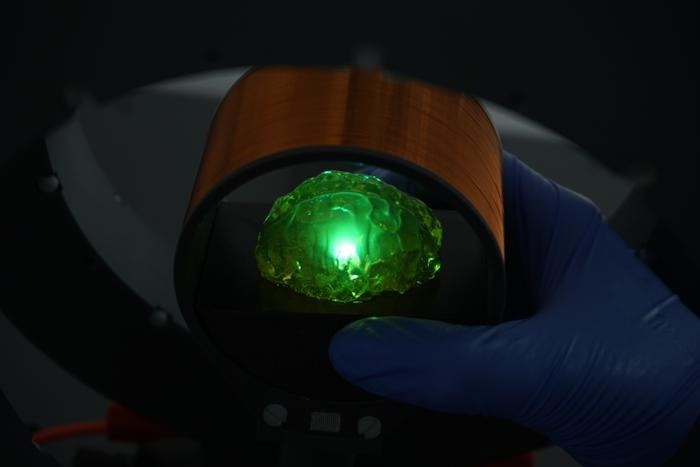Reviewed by Lexie CornerMar 11 2024
A new wireless light source created by a research team from the Universities of St Andrews and Cologne may one day enable the "illumination" of the human body from the inside out.
 Wirelessly powered light bulb illuminating a transparent brain phantom. Image Credit: Julian Butscher
Wirelessly powered light bulb illuminating a transparent brain phantom. Image Credit: Julian Butscher
These light sources have the potential to provide new, less invasive ways to treat and understand diseases that currently necessitate the implantation of large, bulky devices. The research was published in the journal Science Advances.
The novel method based on the integration of organic light-emitting diodes (OLEDs) on “acoustic antennas” is presented by scientists from Germany and Scotland. Currently, acoustic antennas are being investigated for many uses, including low magnetic field detection.
Acoustic antennas have a significant advantage over electric antennas, as they can be made much smaller. OLEDs are made of thin layers of organic materials that can be applied to nearly any surface, and they are frequently found in high-end televisions and smartphones nowadays.
The researchers use this characteristic to deposit OLEDs directly onto the acoustic antenna, combining the unique qualities of both platforms into one incredibly small device. The specially designed OLED is powered by and has a substrate in this manner, thanks to the acoustic antennas. They are used to transform energy from a magnetic field into a mechanical oscillation, which then becomes an electric current.
The new devices function within the sub-megahertz frequency range, commonly utilized in submarine communication due to the weak absorption of electromagnetic fields by water. However, unlike in submarine applications, the intended use in biomedicine necessitates a compact device to prevent adverse effects on tissue.
Since they can be more cell selective and even allow for the stimulation of individual cells, optical stimulation techniques have become a viable substitute for electrical stimulation in recent years. These techniques have yielded promising results in early clinical trials, such as treating an otherwise incurable eye disease.
Our novel wireless light source combines minimal device size, low operation frequency, and optical stimulation. Many emerging applications require multiple sites to be stimulated independently, which is why modern brain stimulators often incorporate a large number of electrodes. In the case of our wireless light sources, the devices can be independently controlled and operated without the need of additional and potentially bulky electronics.
Dr. Malte Gather, Humboldt Professor and Head, Humboldt Centre for Nano- and Biophotonics, Department of Chemistry, Faculty of Mathematics and Natural Sciences, of the University of Cologne
This is possible because various acoustic antennas can have their operating frequencies adjusted to multiple values. In the future, this may enable the individual control of several stimulators across multiple body regions, such as to treat tremors in Parkinson’s disease patients who have advanced symptoms. The researchers aim to further minimize the size of their wireless OLEDs and conduct trials to evaluate their technology in an animal model.
Journal Reference:
Butscher, F. J., et al. (2024) Wireless magnetoelectrically powered organic light-emitting diodes. Science Advances. doi.org/10.1126/sciadv.adm7613.